 (E, c)
= 8° towards <11-20>
(E, c)
= 8° towards <11-20> (E,c) = 8° towards <11-20>
(E,c) = 8° towards <11-20>n+-p-n+ SiC structures
Sankin et al. (2000)
n+-p-n+ SiC structures
Sankin et al. (2000)
n+-p-n+ SiC structures
Sankin et al. (2000)
n+-p-n+ SiC structures
Sankin et al. (2000)

| Remarks | Referens | |||
| Electron saturated drift velocity | 4H-SiC | Vsat = 8.0 x 106 cm/s | 300 K,  (E, c)
= 8° towards <11-20> (E, c)
= 8° towards <11-20> |
Vassilevski et al. (2000) |
| 4H-SiC | Vsat = 7.5 x 106 cm/s | 460K,  (E,c) = 8° towards <11-20> (E,c) = 8° towards <11-20> |
Vassilevski et al. (2000) | |
| 4H-SiC | Vsat = 3.3 x 106 cm/s | RT, E||c, saturation field = 1.55x105 V/cm, n+-p-n+ SiC structures |
Sankin et al. (2000) |
|
| 8H-SiC | Vsat = 1.0 x 106 cm/s | RT, E||c, saturation field = 1.35x105 V/cm n+-p-n+ SiC structures |
Sankin et al. (2000) |
|
| 15R-SiC | Vsat = 1.2 x 106 cm/s | RT, E||c, saturation field = 1.35x105 V/cm n+-p-n+ SiC structures |
Sankin et al. (2000) |
|
| 21R-SiC | Vsat = 4.4 x 103 cm/s | RT, E||c, saturation field = 1.35x105 V/cm n+-p-n+ SiC structures |
Sankin et al. (2000) |
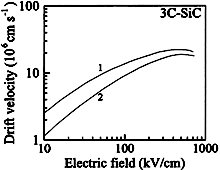 |
3C-SiC. Calculated electron steady-state drift velocity vs. electric
field at 2 different temperatures T. Total concentration of ionized dopants is 1.5x1018cm-3 1 - T = 300 K; 2 - T = 600 K. Mickevicius & Zhao (1998) |
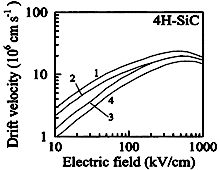 |
4H-SiC. Calculated electron steady-state drift velocity vs. electric
field Doping concentration Nd = 1.5 x 1018 cm-3. 1 - T = 300 K; electric field E||c; 2 - T = 300 K, electric field E 3 - T = 600 K, electric field E||c; 4 - T = 600 K, electric field E Mickevicius & Zhao (1998) |
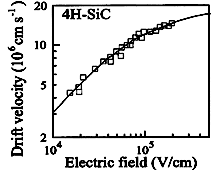 |
4H-SiC. Experimental electron steady state drift velocity vs. electric
field T = 300 K. Electron concentration 1.4 x 1017 cm-3. Mobility in the low electric field is 400 cm2/V·s. Khan & Cooper (1998) |
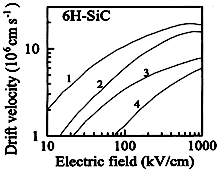 |
6H-SiC. Calculated electron steady-state drift velocity
vs. electric field Doping concentration Nd = 1.5 x 1018 cm-3. 1 - T = 300 K; electric field E  cE||c; cE||c;2 - T = 300 K, electric field E||c; 3 - T = 600 K, electric field E  c; c;4 - T = 600 K, electric field E||c. Mickevicius & Zhao (1998) |
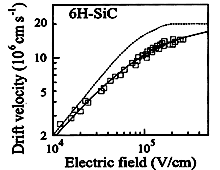 |
6H-SiC. Experimental electron steady state drift velocity vs. electric
field T = 300 K. Electron concentration 1.2 x 1017 cm-3. Mobility in the low electric field is 200 cm2/V·s. Khan & Cooper (1998) |
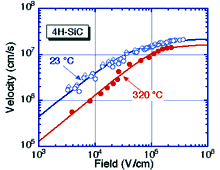 |
6H-SiC. Experimental electron steady state drift velocity vs. electric
field at two temperatures. Solid lines are generated using the equation V(E) = µ E /[1+ ( µ E / Vsat )a ]1/a with parameters: T = 23 K. µ = 450 cm2/Vs, Vsat= 2.2x107 cm/s, a =1.2; T = 320 K. µ = 130 cm2/Vs, Vsat= 1.6x107 cm/s, a =2.2. Khan & Cooper (2000) Contact authors: James A. Cooper. Also see High Field Transport. |
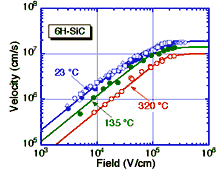 |
6H-SiC. Experimental electron steady state drift velocity vs. electric
field at two temperatures. Solid lines are generated using the equation V(E) = µ E /[1+ ( µ E / Vsat )a ]1/a with parameters: T = 23 K. Mobility µ = 215 cm2/Vs, Vsat= 1.9x107 cm/s, a = 1.7; T = 135 K. Mobility µ = 120 cm2/Vs, Vsat= 1.4x107 cm/s, a = 2.5; T = 320 K. Mobility µ = 56 cm2/Vs, Vsat= 1.0x107 cm/s, a = 4.0. Khan & Cooper (2000) Contact authors: James A. Cooper. Also see High Field Transport. |
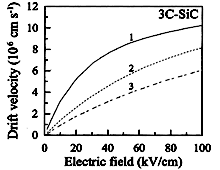 |
3C-SiC. Calculated Hole steady-state drift velocity vs. electric field
applied along (100) direction (relatively low fields) T = 300 K; Impurity concentration: 1 - 0.1 x 1018cm-3; 2 - 1.0 x 1018cm-3; 3 - 7.0 x 1018cm-3. Bellotti et al. (1999) |
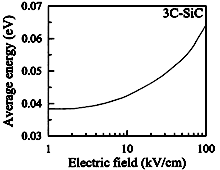 |
3C-SiC. Calculated average Hole energy vs. electric field applied
along (100) direction (relatively low fields). T = 300 K. Bellotti et al. (1999) |
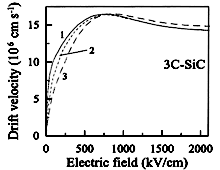 |
3C-SiC. Calculated Hole steady-state drift velocity vs. electric field
applied along (100) direction (high fields). T = 300 K; Impurity concentration: 1 - 0.1 x 1018cm-3; 2 - 1.0 x 1018cm-3; 3 - 7.0 x 1018cm-3. Bellotti et al. (1999) |
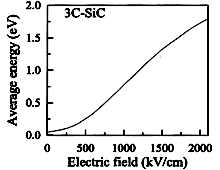 |
3C-SiC. Calculated average Hole energy vs. electric field applied
along (100) direction (high fields). T = 300 K. Bellotti et al. (1999) |